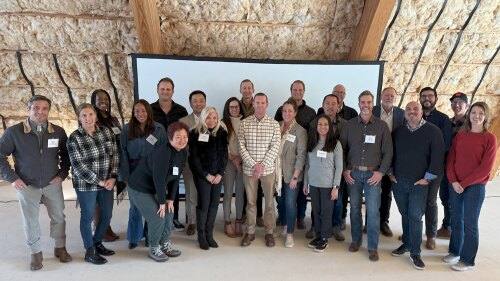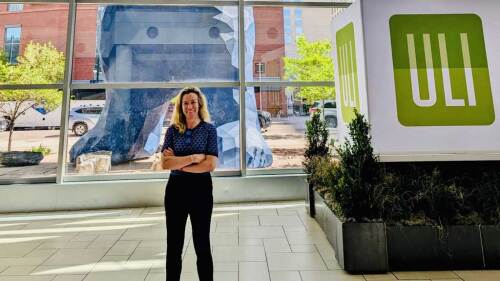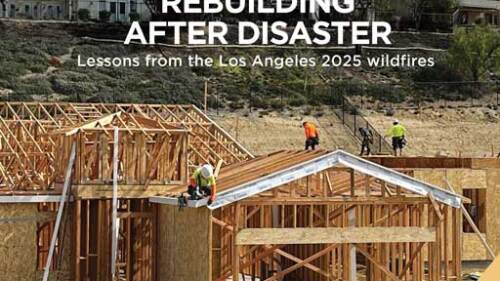Internationally acclaimed artist and urban planner Theaster Gates, whose rise to prominence began with his use of art and culture to revive underserved neighborhoods in his hometown of Chicago, was named the 2018 recipient of the ULI J.C. Nichols Prize for Visionaries in Urban Development at the Institute’s 2018 Fall Meeting in Boston.
The Nichols Prize honors the legacy of Kansas City, Missouri, developer J.C. Nichols, a founding ULI member considered to be one of America’s most creative entrepreneurs in land use during the first half of the 20th century. Gates is the 19th recipient of the prize, which recognizes a person, or a person representing an institution, whose work demonstrates a commitment to the creation of thriving, sustainable communities.
Gates’s creative approach to revitalizing neglected urban neighborhoods—including the reuse of building materials and other items to transform vacant properties into usable space—is what earned him the Nichols Prize, which is the Institute’s highest honor. His studies in urban planning and sculpture have informed and inspired his work, which began on Chicago’s South Side, where he founded the Rebuild Foundation to transform neighborhoods and celebrate innovative artistic practices.
“My work has always aimed to revitalize forgotten spaces and, in doing so, bring together communities that have felt forgotten,” Gates says. “The incredible thing that happens when you revitalize those spaces, preserving elements of their history and infusing them with new purpose, is that you create a platform for communities to participate in their own revitalization.”
Gates and his nonprofit Rebuild Foundation have acquired more than 30 vacant buildings in Chicago for transformation into spaces for affordable housing and community amenities, catalyzing at least $45 million in new investment in the South Side. The foundation hires and trains neighborhood residents to work in construction trades, providing employment opportunities for people to improve the places where they live and infusing a sense of community pride that helps residents who might otherwise be disengaged to become involved stakeholders.
ULI Governing Trustee and Nichols Prize Jury Chairman Michael Spies, senior managing director of Tishman Speyer in New York City, noted that the selection of Gates is a recognition of the way that visionaries whose work extends beyond traditional real estate disciplines are influencing the built environment.
“Many cities are looking to reinvent themselves, and Theaster’s work represents art and culture as important elements of reinvention. He recognized early on the important role his art could play in building a strong community. His model of readapting elements, of repurposing ordinary materials for works of art as well as rebuilding, is a model that clearly has huge potential to be replicated in communities around the world,” Spies said. “He is at once an artist, an entrepreneur, a community builder, and a visionary.”
The next ULI J.C. Nichols Prize for Visionaries in Urban Development winner will be announced at the 2019 ULI Fall Meeting.
Gates spoke with Urban Land about his work, his career, and the guiding princip
les that motivate him.
How has living in a predominantly black working-class community shaped your work?
Anyone who knows Chicago knows that it is a complicated city, because while we talk about it as a city of neighborhoods and a city of communities, it has class and racial divisions that are really nuanced and complicated. What I found is that culture is one of the ways people move between neighborhoods, but education provides the real opportunity. I grew up in an era when people were still busing. I started from a pretty early age synchronizing those ways of living between where I grew up and the other neighborhoods I had access to. It’s that opportunity to see the world through multiple lenses that shaped who I am and what I do. I realized there is no one answer, no one political view that is absolutely right, and from an early age that shaped how I solve problems.
In your view, what is the relationship between urban planning and sculpture?
In college, I was taught that there were rules that shaped the way the world works, and that good planners should learn the rules and abide by them, and if they follow the rules, cities will work well. In sculpture, I was taught that you can take the existing rules of art and change them, bend them, and mold them, and you can forget about the rules to make something greater than the thing that was determined by the rules. These two underlying philosophies of planning and sculpture were in total competition and discord with one another for most of my life. Even now, I live with this tension between following rules and breaking them, especially when it comes to urban planning and the built environment. It seems that the most successful people are those who have decided to try innovative and creative things, those who break the rules to make new things happen. Who’s to say which rules are best?
One of your guiding principles in creating art and creating communities is “work with what you’ve got.” What does using repurposed materials in your projects bring to a project in terms of creativity and inspiration?
I think that “work with what you’ve got” has everything to do with the fact that we have more than we see, and it acknowledges that so much of the work that needs to happen in our communities is not just about the physical place. It’s about acts of love, of mutuality, so that if we build in the mechanisms of communicating more with our neighbors—who these days we are so disconnected from, the idea that we could go next door and say, “Hey, can I use your lawnmower?”—those things don’t exist anymore. Some of it is about retooling communities to work with one another. In my case, I had access to an abundance of raw materials all around, and I had some basic building skills. I could drill a hole and put a screw in it and ensure that something I built would not fall apart. What felt beautiful about that was that I could see significant change at the end of the day. It became a rush, it was like, “Oh, my gosh, how much could I get done today?” Repurposing is part of that, but it’s really about working so that the things that seem only negative or bad or useless—with energy and with skill—become possible. I think that my raw material is more like possibilities and the ability to see that a place that currently looks crazy is actually just waiting for energy to come.
The first Nichols Prize winner was former Charleston, South Carolina, mayor Joseph P. Riley Jr. When he accepted the prize, he spoke about the importance of instilling a sense of pride among residents so that they have a stake in the future of their neighborhoods. This certainly comes across in your work in Chicago’s South Side. What do you think about that concept?
Mayor Riley was up against a tremendous amount of political and social pressure by people who were influential and smart and right in their own way. What you realize is that there are moments when there are different kinds of right. There are rights that are about rights of an individual, and there are rights of the public, and often those things are in tension, particularly when it comes to creating a common space. What you realize is that no one is your friend through the struggle, and everyone is your friend after. It requires a tremendous amount of determination and clarity of purpose and thought in order to push these projects through.
How do you achieve a true “spectacle of diversity”?
When I think about my work, I do often say that I’m not a developer. The reason I say that is because while I understand building buildings and making them affordable is kind of a means to an end, I’m ultimately interested in cultural growth and people having access to cultural experiences that I didn’t have in my neighborhood. That feels almost philanthropic. It feels like part of the calling. If it looks like innovation, the only innovation is that there’s a mission beyond profit.
How do you view what you do as catalyzing or contributing to better development decisions?
What I’ve found is that if we think of development as something that’s just about bricks and mortar, then it’s a very short story. Developers need to remind themselves that they’re partners and allies and brothers. I think that’s when development is better, when it realizes that there are other people who need to be at the table in order to make neighborhoods better and have thriving and healthy, whole communities.
Of all your community building projects, which makes you the proudest and why?
I think the Stony Island Arts Bank [a refurbished former savings and loan at 68th Street and Stony Island Avenue in Chicago that Gates re-created as a repository for neighborhood and African American history] is the project that I care the most about, because in my mind the Bank is a kind of sculpture, and if we were to think about the sculpture as an object, it’s an object or a vessel that allows all these other things to happen. I wanted it to mean something that a black man used his own money to renovate that building, with no other neighborhood investment, and that it was a place for people who live in the neighborhood. Now it’s really a repository, and it’s a place that other people feel they can make investments in. Someone has to start the fire, to catalyze the work, and I think the Arts Bank is a symbol of that.
What worries you most about the way cities are growing? What gives you the most hope?
What worries me is that cities are no longer places where varying classes will live. Great cities more and more are becoming places for the wealthy. That’s bothersome. What gives me hope is that culture or creative thinking as cities change will be one of the things that I think allows for a kind of empathy. I think that we have to continue to educate creative people who will be in opposition to the status quo. We have to find ways of investing in all the people who make cities diverse, who give cities energy and life. Everyone has a right to the city. Only when investments in people are balanced will our cities will remain healthy.







